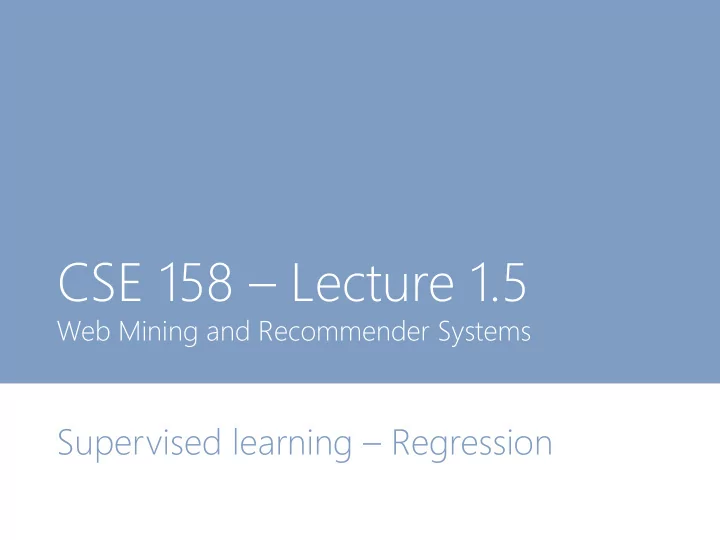

CSE 158 – Lecture 1.5 Web Mining and Recommender Systems Supervised learning – Regression
What is supervised learning? Supervised learning is the process of trying to infer from labeled data the underlying function that produced the labels associated with the data
What is supervised learning? Given labeled training data of the form Infer the function
Example Suppose we want to build a movie recommender e.g. which of these films will I rate highest?
Example Q: What are the labels? A: ratings that others have given to each movie, and that I have given to other movies
Example Q: What is the data? A: features about the movie and the users who evaluated it User features: Movie features: genre, actors, rating, length, etc. age, gender, location, etc.
Example Movie recommendation: =
Solution 1 Design a system based on prior knowledge , e.g. def prediction(user, movie): if (user[‘age’] <= 14): if (movie[‘ mpaa_rating ’]) == “G”): return 5.0 else: return 1.0 else if (user[‘age’] <= 18): if (movie[‘ mpaa_rating ’]) == “PG”): return 5.0 ….. Etc. Is this supervised learning?
Solution 2 Identify words that I frequently mention in my social media posts, and recommend movies whose plot synopses use similar types of language Social media posts Plot synopsis Is this supervised learning? argmax similarity(synopsis, post)
Solution 3 Identify which attributes (e.g. actors, genres) are associated with positive ratings. Recommend movies that exhibit those attributes. Is this supervised learning?
Solution 1 (design a system based on prior knowledge) Disadvantages: Depends on possibly false assumptions • about how users relate to items Cannot adapt to new data/information • Advantages: Requires no data! •
Solution 2 (identify similarity between wall posts and synopses) Disadvantages: Depends on possibly false assumptions • about how users relate to items May not be adaptable to new settings • Advantages: Requires data, but does not require labeled • data
Solution 3 (identify attributes that are associated with positive ratings) Disadvantages: Requires a (possibly large) dataset of movies • with labeled ratings Advantages: Directly optimizes a measure we care about • (predicting ratings) Easy to adapt to new settings and data •
Supervised versus unsupervised learning Learning approaches attempt to model data in order to solve a problem Unsupervised learning approaches find patterns/relationships/structure in data, but are not optimized to solve a particular predictive task Supervised learning aims to directly model the relationship between input and output variables, so that the output variables can be predicted accurately given the input
Regression Regression is one of the simplest supervised learning approaches to learn relationships between input variables (features) and output variables (predictions)
Linear regression Linear regression assumes a predictor of the form matrix of features vector of outputs unknowns (labels) (data) (which features are relevant) (or if you prefer)
Linear regression Linear regression assumes a predictor of the form Q: Solve for theta A:
Example 1 How do preferences toward certain beers vary with age?
Example 1 Beers: Ratings/reviews: User profiles:
Example 1 50,000 reviews are available on http://jmcauley.ucsd.edu/cse158/data/beer/beer_50000.json (see course webpage) See also – non-alcoholic beers: http://jmcauley.ucsd.edu/cse158/data/beer/non-alcoholic-beer.json
Example 1 Real-valued features How do preferences toward certain beers vary with age? How about ABV ? (code for all examples is on http://jmcauley.ucsd.edu/cse158/code/week1.py)
Example 1 Real-valued features What is the interpretation of: (code for all examples is on http://jmcauley.ucsd.edu/cse158/code/week1.py)
Example 2 Categorical features How do beer preferences vary as a function of gender ? (code for all examples is on http://jmcauley.ucsd.edu/cse158/code/week1.py)
Example 3 Random features What happens as we add more and more random features? (code for all examples is on http://jmcauley.ucsd.edu/cse158/code/week1.py)
Exercise How would you build a feature to represent the month , and the impact it has on people’s rating behavior?
Recommend
More recommend